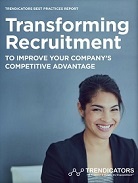
 Did you know that HR technology has the power to predict the future? No, it’s not a crystal ball that can tell you where to find your next VP of Finance or how long that new IT tech will stay at your company. But it can give you the data and analytics competence you need to make reasonable predictions and more profitable decisions in situations like these. The trouble is that HR leaders have been slow to jump on the bandwagon. If you’re among them, here’s why you should take the leap.
Did you know that HR technology has the power to predict the future? No, it’s not a crystal ball that can tell you where to find your next VP of Finance or how long that new IT tech will stay at your company. But it can give you the data and analytics competence you need to make reasonable predictions and more profitable decisions in situations like these. The trouble is that HR leaders have been slow to jump on the bandwagon. If you’re among them, here’s why you should take the leap.
How Analytics Changes the Way You Approach HR
Small data-based adjustments to your strategy can make huge impacts. Without data, you’ll just be guessing (and you might not even notice any problems in the first place). Data analysis, however, helps you both recognize needs and identify the most likely causes and solutions.
Bottom line: Advanced analytics turns guesswork into knowledge. It can also help you:
- Make better hiring decisions – Hiring the right talent is a top priority for most HR executives. Quality candidates who also fit the company culture have become today’s purple squirrels, and it often takes advanced analysis of candidate data to source, screen and hire the best people.
- Promote employee engagement – Analytics tools that not only crunch numbers and percentages but also evaluate non-numeric feedback such as performance review responses or engagement survey results can give you valuable insight into why your employees are (or aren’t) engaged. They can also provide a framework for promoting engagement by helping you monitor and improve the most common contributors to employee satisfaction.
- Reduce turnover and increase retention – What causes employee churn in your company? Do top performers tend to stay with your company or do they leave quickly? How can you improve retention? You can find answers to questions like these by monitoring KPIs such as employee experience index, retention rate, turnover rate and employee productivity score. Predictive analytics can also help you make adjustments to your hiring process, onboarding strategy and company culture to promote engagement and retention among your best workers.
- Boost productivity – Engagement is a reliable predictor of performance. To improve workforce productivity, you have to understand how to promote higher engagement and satisfaction on the job. That starts with collecting frequent, consistent feedback and analyzing it for trends such as how employees respond to performance management techniques, leadership styles and company policies.
How to Take the Next Step
If you haven’t delved into the possibilities of analytics at all yet, it’s okay to start small. You don’t have to invest in state-of-the-art technology right away, and your current HR software probably already has some analytics tools you can use to get your feet wet.
If you already use analytics, but you’re ready for some deeper results, investing in new technology may be the right move for your organization. Either way, here are some additional steps you can take to create a powerful analytics strategy:
- Ensure proper data collection and management.
To get insights that will make a difference in your bottom line and your workforce productivity, clean, reliable data is a must. That means you need a data governance policy that sets guidelines for collecting, managing, storing and protecting your data.
- Learn from others.
Observe what others in your industry are doing to make the most of their data by attending conferences, asking questions and possibly even scheduling a training seminar for your team. Remember that there are two sides to effective analytics: reliable data and statistical analysis. Don’t make the mistake of pursuing one to the exclusion of the other.
- Ask questions.
Start with basic questions about what your data goals are, what answers you want to obtain from your data, which tools will give you the information you need and how analytics can bring the most value to your company. At the executive level, talk about what role analytics should play in the overall strategy of your HR department and whether you will need additional staff to manage and analyze your data.
- Invest in the right technology.
Many HR departments are running on outdated software platforms, but the right technology positions you to collect, store and analyze data more effectively for better business decisions and a more productive workforce. It also gives you a good foundation for future growth and innovation.
HR is the lifeblood of your company, because this department touches every employee who walks through the door. Strategic analytics initiatives in the HR department will help inform your people strategy to maximize employee engagement and performance.


